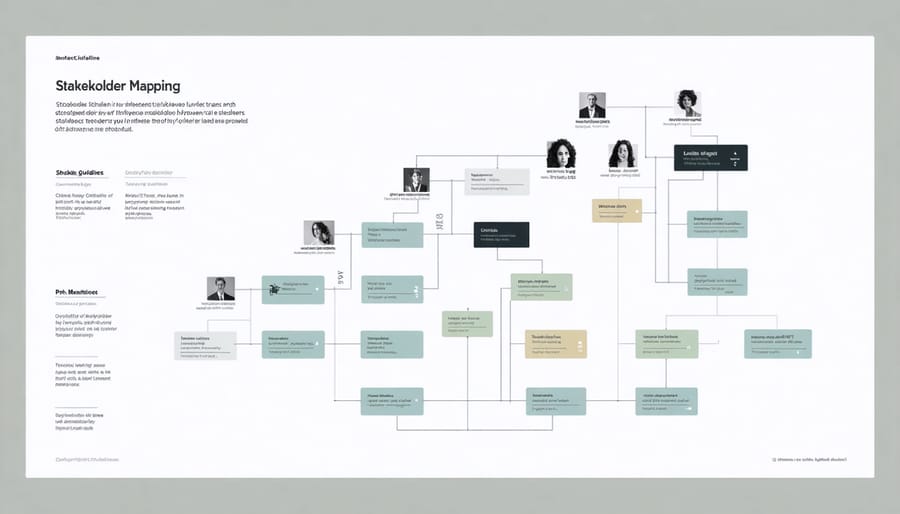Transform stakeholder management from a project challenge into a strategic advantage by implementing a systematic, data-driven engagement framework. Modern construction projects demand sophisticated approaches to navigate complex stakeholder relationships, with research showing that projects achieving the highest benefits of effective stakeholder engagement secure 23% higher completion rates and 30% better budget adherence.
Map stakeholder influence through digital assessment tools, prioritizing engagement based on impact matrices and real-time project dynamics. Construction leaders must integrate stakeholder feedback loops into every project phase, from pre-construction planning through project delivery, utilizing advanced communication platforms and automated reporting systems to maintain transparency and accountability.
Implement a three-tier engagement strategy: strategic partnerships with primary stakeholders (owners, investors, regulatory bodies), collaborative relationships with secondary stakeholders (subcontractors, suppliers), and informed communication with tertiary stakeholders (local communities, media). This structured approach, combined with digital stakeholder management platforms, creates a robust framework for managing diverse interests while maintaining project momentum.
The Evolution of Stakeholder Collaboration in Construction
Key Stakeholder Groups in Modern Construction
Modern construction projects involve diverse stakeholder groups, each playing crucial roles in project success. Stakeholder collaboration in construction requires understanding these key groups and their specific interests.
Developers and investors focus on project viability, ROI, and timeline adherence. They often drive major decisions and bear significant financial risks. Contractors and subcontractors concentrate on operational efficiency, resource allocation, and meeting project specifications while maintaining profitability.
Architects and design professionals prioritize aesthetic excellence, functionality, and technical innovation. Their creative vision must align with practical constraints and regulatory requirements. Engineering teams ensure structural integrity, safety compliance, and systems integration.
Local communities and residents represent vital stakeholders whose daily lives may be impacted by construction activities. Their concerns typically include noise levels, environmental impact, and neighborhood transformation. Regulatory bodies and government agencies oversee compliance with building codes, environmental regulations, and safety standards.
Supply chain partners, including material suppliers and equipment providers, influence project timelines and cost management. Finally, end-users or occupants focus on functionality, comfort, and long-term sustainability of the completed structure.

Current Challenges in Stakeholder Management
Managing stakeholder interests in modern construction projects presents several significant challenges. The increasing complexity of projects, coupled with diverse stakeholder expectations, often leads to competing priorities and potential conflicts. Project managers frequently struggle with balancing the demands of investors seeking quick returns against community groups advocating for environmental considerations or local impact mitigation.
Communication barriers present another substantial hurdle, particularly in large-scale projects involving multiple stakeholders across different time zones and cultural contexts. The challenge intensifies when stakeholders have varying levels of technical understanding, requiring careful translation of complex project details into accessible information.
Resource allocation remains a persistent challenge, with limited time and budget constraints affecting the depth of engagement possible with each stakeholder group. Project teams must also navigate regulatory compliance while maintaining positive relationships with government bodies and local authorities.
Digital transformation poses both opportunities and challenges, as traditional engagement methods evolve into digital platforms. While technology enables broader reach, some stakeholders may resist these changes or lack access to digital tools, creating potential engagement gaps that need careful consideration and alternative solutions.
Building an Effective Engagement Framework
Early Stakeholder Identification and Analysis
Early stakeholder identification is a critical first step in developing an effective engagement strategy for construction projects. The process begins with comprehensive stakeholder mapping, which involves identifying all parties who may influence or be affected by the project. This includes direct stakeholders such as clients, contractors, and regulatory bodies, as well as indirect stakeholders like local communities, environmental groups, and utility companies.
A systematic approach to stakeholder analysis typically employs tools such as power-interest matrices and influence-impact grids. These frameworks help categorize stakeholders based on their level of authority, interest in the project, and potential impact on project outcomes. For instance, high-power, high-interest stakeholders often require intensive engagement and regular communication, while low-power, low-interest stakeholders may need only periodic updates.
Project teams should conduct detailed stakeholder interviews and workshops during the initial project phases to understand specific concerns, expectations, and potential conflicts. This information forms the foundation for developing targeted engagement strategies and communication plans.
Key factors to consider during analysis include:
– Stakeholder’s organizational role and decision-making authority
– Historical relationship with similar projects
– Potential conflicts of interest
– Available resources and capacity for engagement
– Cultural and social considerations
– Legal and regulatory requirements
Regular review and updates of stakeholder analysis ensure the engagement strategy remains responsive to changing project dynamics and emerging stakeholder relationships throughout the project lifecycle.

Communication Protocols and Tools
Effective stakeholder engagement relies heavily on establishing clear communication protocols and leveraging appropriate digital tools. In construction projects, a multi-channel approach ensures comprehensive coverage and accessibility for all stakeholders.
Primary communication channels should include regularly scheduled in-person meetings, video conferences, and written updates through email or project management platforms. For time-critical communications, establish a clear escalation protocol that defines response times and responsible parties.
Modern digital tools have revolutionized stakeholder engagement. Project management software like Procore or PlanGrid enables real-time document sharing and collaboration. Building Information Modeling (BIM) platforms facilitate visual communication of complex design elements, particularly useful when engaging with non-technical stakeholders.
Document control systems should be implemented to maintain communication records and ensure version control. This includes standardized templates for meeting minutes, progress reports, and change requests. Cloud-based collaboration platforms enable stakeholders to access project information securely from any location.
For large-scale projects, consider implementing a dedicated stakeholder management system that tracks engagement activities, monitors feedback, and generates automated reports. Mobile applications can facilitate field communications and immediate issue reporting.
Regular feedback mechanisms, such as online surveys and digital feedback forms, help measure engagement effectiveness and identify areas for improvement. Remember to maintain consistent branding and formatting across all communication channels to reinforce project identity and professionalism.
Risk Management Through Engagement
Proactive stakeholder engagement serves as a powerful risk mitigation tool in construction projects. By identifying and addressing stakeholder concerns early, project teams can prevent costly delays, conflicts, and resource allocation issues that often plague construction initiatives. Studies show that up to 70% of project management risks can be significantly reduced through strategic stakeholder engagement.
Regular communication channels and feedback loops enable project teams to detect potential issues before they escalate into major problems. For instance, early engagement with local communities can reveal concerns about construction noise or environmental impact, allowing teams to adjust schedules or implement additional protective measures proactively.
Engagement strategies should include structured risk assessment workshops with key stakeholders, regular progress updates, and collaborative problem-solving sessions. This approach helps build trust while creating a shared understanding of project objectives and constraints. Experience shows that when stakeholders feel their voices are heard and their interests considered, they’re more likely to support the project through challenges rather than become obstacles.
Digital platforms and management tools can streamline this process by providing real-time updates, document sharing, and communication tracking. This transparency helps maintain stakeholder confidence and ensures that risk mitigation efforts are properly documented and monitored throughout the project lifecycle.
Digital Solutions for Stakeholder Collaboration
Collaborative Platforms and BIM Integration
In today’s construction landscape, effective stakeholder engagement increasingly relies on sophisticated digital collaboration tools and Building Information Modeling (BIM) integration. These platforms create a unified digital environment where stakeholders can interact, share information, and make informed decisions in real-time.
Modern BIM collaboration platforms enable stakeholders to visualize project developments, track progress, and provide feedback through intuitive interfaces. Key features typically include 3D model sharing, document management, clash detection, and integrated communication channels. This technological integration significantly reduces communication barriers and minimizes the risk of misunderstandings between parties.
Cloud-based project management systems further enhance stakeholder engagement by providing secure, accessible platforms for document sharing, version control, and approval workflows. These systems maintain a clear audit trail of decisions and communications, crucial for accountability and project governance.
The integration of mobile applications allows stakeholders to participate in project discussions and decision-making processes regardless of their location. Real-time notifications and updates ensure all parties remain informed of project developments, while collaborative markup tools facilitate direct feedback on designs and documents.
For optimal implementation, organizations should select platforms that align with their stakeholders’ technical capabilities and project requirements, ensuring user adoption and meaningful engagement throughout the project lifecycle.

Data-Driven Decision Making
Effective stakeholder engagement relies heavily on data analytics and systematic information processing to drive strategic decisions. By collecting and analyzing stakeholder feedback, interaction patterns, and engagement metrics, construction organizations can develop more targeted and successful engagement strategies.
Key performance indicators (KPIs) should be established to measure stakeholder satisfaction, response rates, and participation levels in project discussions. These metrics provide valuable insights into engagement effectiveness and areas requiring improvement. Modern project management platforms enable real-time data collection and visualization, allowing teams to track stakeholder sentiment and address concerns proactively.
Implementing a data-driven approach involves:
– Regular stakeholder surveys and feedback collection
– Analysis of communication patterns and response times
– Tracking of issue resolution rates and stakeholder satisfaction scores
– Monitoring of engagement levels across different communication channels
– Assessment of stakeholder influence and impact matrices
This quantitative approach helps identify trends, predict potential conflicts, and allocate resources more effectively. For instance, data analysis might reveal that certain stakeholder groups prefer specific communication channels or that particular concerns consistently arise at specific project phases.
Organizations should establish a systematic review process for stakeholder data, ensuring that insights directly inform strategy adjustments and decision-making. This iterative process of collecting, analyzing, and acting on stakeholder data creates a continuous improvement cycle that enhances project outcomes and stakeholder relationships.
Case Study: Successful Stakeholder Engagement
The Denver International Airport Terminal Expansion Project (2018-2022) stands as a compelling example of successful stakeholder engagement in a complex construction environment. This $770 million renovation project involved multiple stakeholders, including airport authorities, airlines, retail concessionaires, local government officials, and the traveling public.
The project team implemented a comprehensive engagement strategy that began with early stakeholder identification and systematic mapping of interests and influence levels. They established a dedicated stakeholder coordination office that served as a central hub for communication and issue resolution.
Key to their success was the implementation of a three-tier communication framework:
– Weekly collaborative sessions with direct stakeholders
– Monthly town hall meetings with broader stakeholder groups
– Quarterly progress reviews with executive leadership
The project team utilized digital collaboration platforms to maintain real-time communication with all parties, sharing construction updates, timeline adjustments, and impact assessments. They also developed a mobile app that provided stakeholders with instant access to project information and a direct channel for feedback.
One notable challenge arose when retail concessionaires expressed concerns about construction impact on their operations. The project team responded by adjusting work schedules and creating temporary pathways to maintain customer flow. This flexibility in approach resulted in a 15% reduction in business disruption compared to initial projections.
The engagement strategy yielded measurable results:
– 92% stakeholder satisfaction rate
– 30% reduction in project delays
– 25% decrease in change orders
– Maintained airport operations at 95% capacity during construction
This case study demonstrates how proactive stakeholder engagement, supported by clear communication channels and flexible problem-solving, can significantly contribute to project success. The approach has since been adopted as a best practice model by several major infrastructure projects across North America.
In today’s complex construction landscape, effective stakeholder engagement has become more critical than ever. As our industry continues to evolve, successful projects increasingly depend on the ability to build and maintain strong relationships with diverse stakeholder groups while leveraging modern technologies and communication strategies.
The future of stakeholder engagement in construction points toward greater integration of digital tools, real-time collaboration platforms, and data-driven decision-making processes. Organizations that embrace these innovations while maintaining personal connections with stakeholders will be better positioned to deliver successful projects and maintain competitive advantages.
Key success factors include developing comprehensive engagement frameworks, implementing regular feedback mechanisms, and maintaining transparent communication channels. Project managers must continue to adapt their approaches as stakeholder expectations evolve, particularly regarding sustainability, community impact, and digital integration.
Looking ahead, we can expect to see increased emphasis on early stakeholder involvement, more sophisticated engagement analytics, and greater focus on measuring stakeholder satisfaction throughout the project lifecycle. The rise of virtual reality and augmented reality technologies will also transform how stakeholders interact with project plans and visualize outcomes.
For construction professionals, the message is clear: stakeholder engagement is not just a project requirement but a strategic imperative that directly impacts project success. By adopting proactive engagement strategies and embracing technological advances, organizations can build stronger relationships, minimize risks, and achieve better project outcomes for all parties involved.

